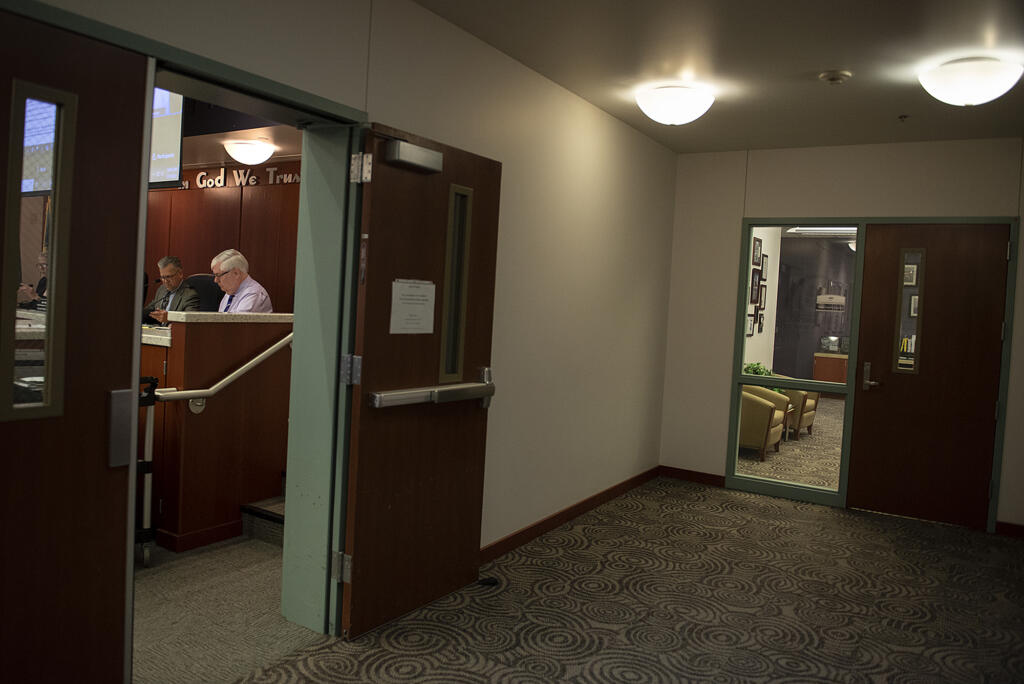The Clark County Council is considering a resolution that supports an Interstate 5 replacement bridge but also “opposes every light rail project in Clark County unless it is first supported by a majority of the voters in a countywide advisory vote of the people.”
Instead, the council would support C-Tran’s bus rapid transit as the best alternative, according to the resolution.
The council reviewed the proposal at its meeting Wednesday but won’t take a vote to adopt or reject the resolution until a later date. The resolution would have limited impact, since Clark County is not included among the regional partner agencies involved in the bridge replacement effort.
Councilor Temple Lentz said she only had time to skim the resolution and a related white paper because they were not made available until late Tuesday. She said she needed more time to review both documents thoroughly.
The Interstate Bridge Replacement Program has been circulating its locally preferred alternative to local jurisdictions for support before it can move on to the next project phase. Included in the design is the expansion of light rail from Portland, an idea that has drawn a mix of support and opposition.
“The different surveys that have been taken over time, and in particular the one the IBR team reported, that 78 percent of Washington residents have as their top priority reducing traffic congestion and saving time,” Council Chair Karen Bowerman said.
Bowerman said, to her knowledge, only Washington has allocated funds for the I-5 replacement bridge and that neither Oregon nor the federal agencies involved have indicated how much they will contribute, if any.
“The locally preferred alternative that has been modified and is contained in IBR’s materials … is very relevant for us understanding what is proposed,” Bowerman added.
She said the white paper takes the position that C-Tran’s bus service would be the ideal choice, especially when compared with TriMet’s light rail.
Bowerman said part of the opposition to light rail stems from the $1.3 billion to $1.8 billion in additional costs associated with extending existing service into Clark County. She said additional tax revenues would be needed to fund the expansion, where C-Tran’s costs for bus service would be far less.
Lentz, who represents the county on the Regional Transportation Council’s board of directors, said the need for tax revenues was true for the Columbia River Crossing project but not the Interstate Bridge Replacement Program.
“It’s one of the key things that is different about this process than the last one, and especially C-Tran heard much of the opposition the last time around and is standing very firm on a few points,” Lentz said.
Lentz said C-Tran has been consistent that Clark County residents will not be asked to pay for the light rail portion of the project, adding she expects to see that in writing before the C-Tran board in the next few weeks.
Lentz also noted that the city of Vancouver, which she said would be most impacted by the project, has already announced its support for bringing light rail into downtown and hoped the county council would follow suit.
“I would love to see a rework … so that instead of opposing light rail that we adjusted some of the language to say that if at any time this project requires Clark County or C-Tran money for light rail, then it would require a vote of the people,” Lentz said.
Another point of opposition, Bowerman said, was that travel times across the bridge could be as much as 30 minutes longer once the bridge is completed. To address this, the resolution calls for a fourth travel lane to be added to the design, as well as a truck-only lane.
Councilor Gary Medvigy said he fully supported the resolution.
“This is all about an old bridge that doesn’t meet engineering standards and there’s no practical way to retrofit it to be seismically fit by today’s standards,” Medvigy said. “At some point, maintenance becomes more costly, ultimately, than replacing it and putting in a brand new bridge.”
While he agrees with the need for a new bridge, he isn’t happy with some of the decisions made by the IBR committee.
“I don’t understand how this is morphing the way it is,” Medvigy said. “All of a sudden we’re talking about tolling, Oregon’s talking about value pricing on top it, and we’ve suddenly added light rail. We’re doing nothing to increase freight mobility. We’re doing nothing to relieve congestion.”
Medvigy said the only way to achieve all of those goals is adding another travel corridor, bridge or tunnel with light rail and heavy rail separate from the design.
“You get redundancy and resiliency by having additional mechanisms,” he said.
Greg Johnson, IBR program administrator, said the project team welcomes feedback from the many users and stakeholders with an interest in the bridge project. Johnson said that feedback helps ensure the varied needs and perspectives of the community are heard and understood.
Johnson said the IBR team has been working in collaboration with local partners to identify the key elements of the locally preferred alternative.
“This work has included many considerations, including technical work and extensive community engagement, to identify a solution that best balances the bistate needs and priorities of the communities on both sides of the river,” Johnson said, adding the locally preferred alternative is not the final design but a key milestone “that identifies the foundational elements regional partners agree should be further evaluated and tested through the environmental review process.”
Johnson said the Interstate Bridge Replacement Program will continue to invite that feedback as the project moves into the state environmental impact study process and other phases.
“We understand the vital link the bridge plays in connecting the region and are committed to a multimodal solution that will improve our transportation system, now and in the future,” Johnson said.
The council will again review the resolution at its next meeting at 9 a.m. July 6. The complete resolution and white paper are available on the county website by clicking on the county council meetings and agendas link.




